The AMD Ryzen AI 9 HX 370 Review: Unleashing Zen 5 and RDNA 3.5 Into Notebooks
by Gavin Bonshor on July 28, 2024 9:00 AM ESTSystem & Storage Performance
The next section of our updated notebook test suite includes web and office-based tests. Our updated notebook suite runs in parallel with our current CPU test suite for 2024. It also allows us to blend mobile chips tested with desktop chips, mainly to see how efficiency and performance levels stack up for each generation we try.
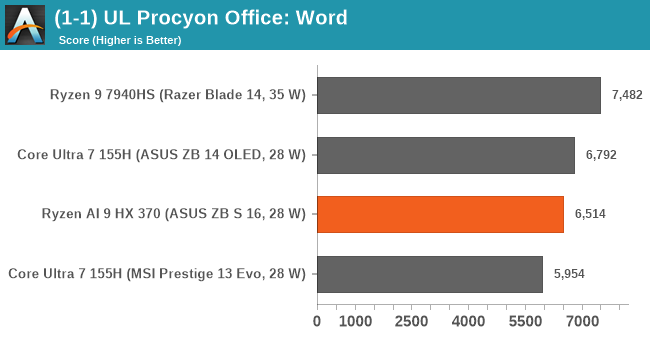
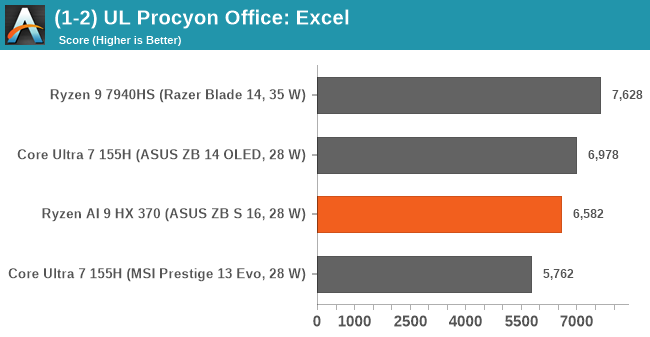
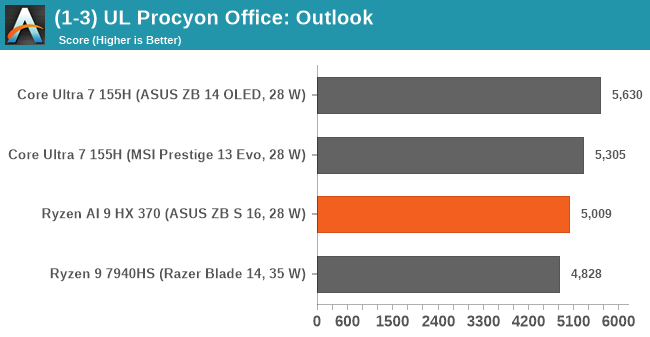
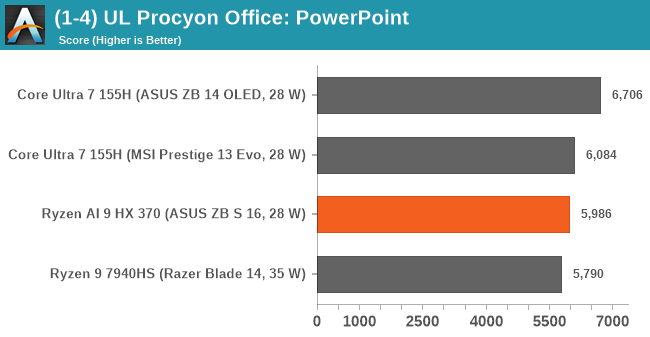
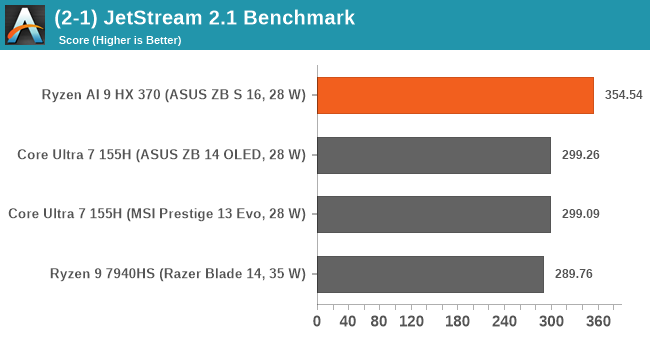
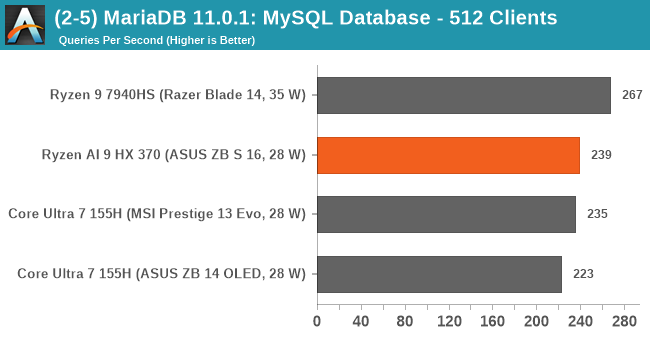
Looking at the Ryzen AI 9 HX 370's performance in our web and office-based tests, we see middle-of-the-road performance compared to the other mobile chips on the test. One example of where we see the Ryzen AI 9 HX 370 comfortably come out on top is in the JetStream 2.1 web-based benchmark, which looks at a wide variety of JavaScript and WebAssembly workloads. Things overall aren't really much different between the chips in terms of performance in this section of the suite.
Storage
When it comes to ultrathin notebooks, finding the right balance between storage performance and having the means to be able to keep it cool is quite the trade-off. There's more to storage performance than just putting in the fastest drive you can; other variables include the interface used, the quality of the controller, and the overall drive. The ASUS Zenbook S 16 (UM5606WA) includes a single 1 TB drive, which, in our sample, is made by Micron. ASUS uses the Micron 2400 MTFDKBA1T0QFM, a QLC drive with a PCIe 4.0 x4 interface controller.
Looking at read and write performance using CrystalDiskMark 8.0.5, we see sequential read speeds of just over 5000 MB/s, with write speeds around the 2750 MB/s mark. It's a decent level of throughput for an ultrathin notebook, but it's not setting any records. The Micron drive used here is an budget design – DRAMless with QLC NAND – and for better or worse, is pretty typical fare for OEM laptops.
When judging and measuring storage performance, it comes down to real-world performance and ensuring optimal cooling, especially on these fast NVMe drives, which can run very hot and thermally throttle, reducing performance.


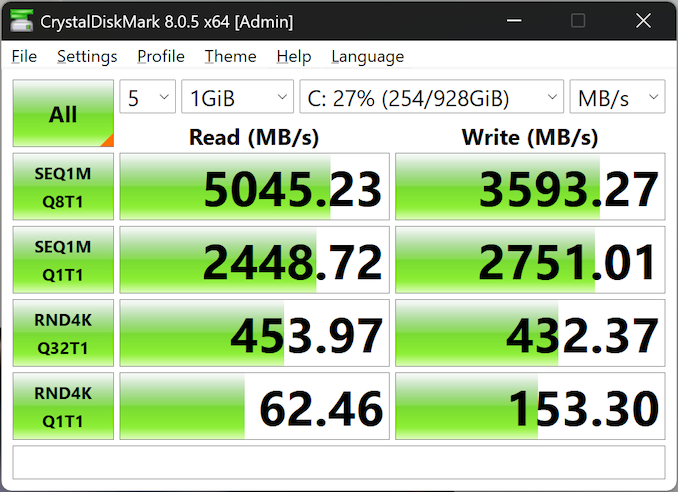








72 Comments
View All Comments
Dante Verizon - Sunday, July 28, 2024 - link
Why are you comparing an ultra-thin design to a CPU with PL2 at almost 90w? The notebookcheck tests show that the Zenbook runs up to 50% slower than the ProArt chassy.Ryan Smith - Sunday, July 28, 2024 - link
Sorry, which notebook are you referring to? We have multiple Zenbooks here.Terry_Craig - Sunday, July 28, 2024 - link
He's probably talking about the Zenbook in the review: https://www.notebookcheck.net/Asus-Zenbook-S-16-la...Strix performs much worse on the Zenbook than inside the ProArt, probably due to more aggressive power and temperature management.
Ryan Smith - Sunday, July 28, 2024 - link
It's definitely not a high performance chassis, despite being 16-inches. The default TDP is just 17 Watts; AMD asked reviewers to bump it up to 28W.But this is what AMD sent out for review. Given the wide range of laptop TDPs out there, these review unit laptops can never cover the full spectrum. So it's more a reflection of what power level/form factor the chipmaker is choosing to prioritize in this generation.
The Hardcard - Sunday, July 28, 2024 - link
What is the 90W laptop in this review? The other laptops are listed at 28W and 35W here. I did not see any indication of the power specifications of the ProArt on the other site, just some numbers provided. I strongly suspect that laptop is running at top TDP, 45-54W.So, like, a different comparison.
Terry_Craig - Sunday, July 28, 2024 - link
https://www.notebookcheck.net/AMD-Ryzen-9-7940HS-P...Depending on the model, the 7940HS goes up to 100w.
The Hardcard - Monday, July 29, 2024 - link
But, is the 7940HS pulling 100w in this review instead of the reported 35w? Otherwise,, what is the point of the complaint?https://www.ultrabookreview.com/69005-asus-proart-...
The HX 370 is in a different chassis pulling 80w sustained. Does that make the 35w vs 28w happening here more fair? I mean, if what the chips can draw elsewhere somehow matters here at all?
eastcoast_pete - Monday, July 29, 2024 - link
It matters if one wants to look at the maximum performance possible, regardless of power draw. But, in addition to what Ryan wrote, the attraction of the HX Series to me is the strong performance at lower power draws. I would have actually liked to see performance comparisons at 17 W, which IMHO is of special interest in such thin and light notebooks. The higher end (> 50 W) will be if interest for Strict Halo, which as far as I can tell is supposed to take on notebooks with smaller dGPUs.ET - Sunday, July 28, 2024 - link
From the benchmarks here, the 370 looks somewhat disappointing on the CPU front, with some losses to 8 cores Zen 4. A hybrid architecture is always a problem. I wonder if future scheduling changes will help or if the small 8MB L3 for the Zen 5c cores is a problem that can't be overcome.The new GPU however looks like a good upgrade over the previous gen.
nandnandnand - Sunday, July 28, 2024 - link
It's hybrid with different cache amounts, but it's also two CCXs instead of one after 3.5 generations of simple 8-cores. It's hard to say what's screwing it up.Phoronix's review was more positive for the CPU. The main benefit is power efficiency:
https://www.phoronix.com/review/amd-ryzen-ai-9-hx-...
The reviews I looked at didn't look too good for the GPU. Maybe it will do better with more power, but what it really needs is memory bandwidth. Hopefully AMD brings some Infinity Cache to its mainstream 128-bit APUs in the future.